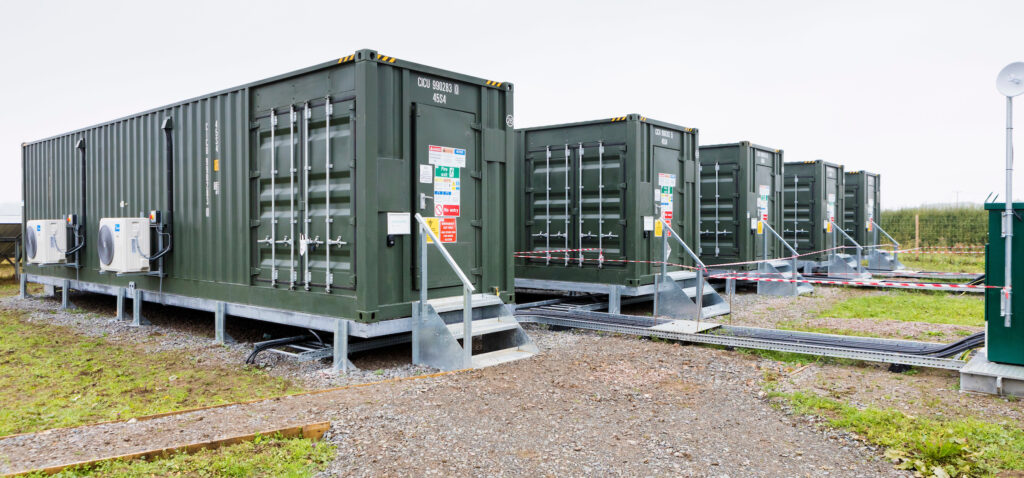Battery assets have been used in the Balancing Mechanism for the first time via a virtual power plant, marking the start of a new era in energy storage revenues in the UK.
Limejump became the first aggregator with a supply licence to bring active Balancing Mechanism Units (BMUs) made up of aggregated capacity into the Capacity Market after Ofgem granted it special dispensation to do so last week.
The 10MW Breach Farm battery storage project in Derbyshire , developed by renewables firm Anesco, was the first to participate in the BM via Limejump’s Virtual Power Plant and was later followed by the Clay Hill, the UK’s first subsidy free solar farm, made up of 10MW of solar combined with 6MW of battery storage.
Steve Shine, executive chairman of Anesco, the owner and operator of both sites, said: “We’re delighted that we’ve been able to achieve another first for the UK renewables industry. By entering our storage assets into the Balancing Mechanism, the door has been opened to additional revenue streams for investors and further validates the opportunity that battery storage provides.
“It’s a major step forward for the industry, with the Balancing Mechanism market offering frequent instances of profitable spreads for batteries to take advantage of. In addition, it removes much of the risk that suppliers face from uncertain system prices.”
Anesco identified the BM last year as a ‘key revenue stream’ unavailable to sub-50MW generators, and worked with consultancy Cornwall Insight to develop a new structure for storage projects. This was particularly needed after the market for firm frequency response became oversubscribed, resulting in substantially reduced revenues, and de-rating in the Capacity Market saw short duration batteries hit.
Lily Coles, commercial operations director at Anesco, explained: “Investors have traditionally been relying on getting an FFR contract and a Capacity Market contract and we all know that is not available anymore and you can’t rely on that financial model.
“The key point for us in being able to have the first battery in [the BM] is demonstrating and opening up that new revenue stream for batteries and then building up that case data to provide more security to investors by demonstrating where they can make their returns.
“That’s the significant milestone; it’s finally been opened up and is now an opportunity for batteries to enter into,” she said.
Anesco’s model hopes to combine BM and wholesale trading to during the day with night time frequency response to offer alternative revenue streams than have previously been exploited by battery storage projects.
While access to the BM is “incredibly significant” as a new revenue source according to Coles, it is not strong enough to build an entire business case on as prices fluctuate depending on the needs of National Grid throughout the day.
Writing for Current± in June, Flexitricity – which is preparing for its BM entry in October – said that on rare occasions, prices can reach £2,500/MWh, compared to around £50/MWh in wholesale markets. However, the company added the price had reached above £100/MWh about a third of the time over the last two years.
Nevertheless, the number of signals sent by National Grid in just the first week of entry into the market increased according to Limejump’s head of marketing, Joshua Greedy. He added that as pressures on the grid increase over the winter this is likely to increase further, meaning multiple assets within Limejump’s aggregated BMUs will be required.
Coles added: “The opportunities under the BM are huge. If you look at National Grid and the National Infrastructure Commission, they’re saying the opportunity could double by 2021 in the BM alone.
“National Grid were really happy with Breach Farm last week and even they were saying they could see batteries dominating that market, [but] it depends how quickly people install batteries.”
A new opportunity for solar plus storage
The use of Clay Hill in the BM has also given a new unique opportunity to the solar farm, with entry into the market by a battery charged on site by solar being more cost effective than a standalone battery importing from the grid.
“With the [Clay Hill] battery, you’re not having to buy power in order to discharge within the BM. A huge issue you have with batteries at the moment is the import charges [which] you’re avoiding by using the solar generation.
“So we really can’t see why investors won’t be going for [that] hybrid solution because it’s got so many advantages to it. The strike price that you have to enter Breach Farm as a standalone battery is a lot higher than Clay Hill because Clay Hill can make the same spread by using the renewable generation,” Coles continued.
The new entry for Clay Hill into the BM tops off a successful summer for the project, which according to Cole is “exceeding all our expectations.”
Owing to high irradiation over the summer months, combined with a lack of wind generation and reduced output from French power stations leading to higher electricity prices, solar generation from Clay Hill was able to sell for an average price of £56/MW.






